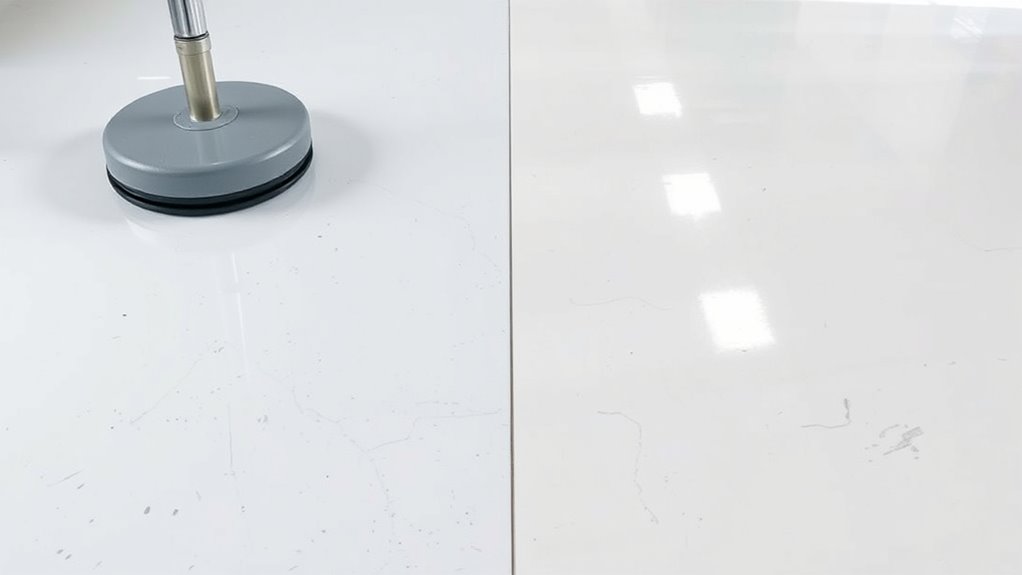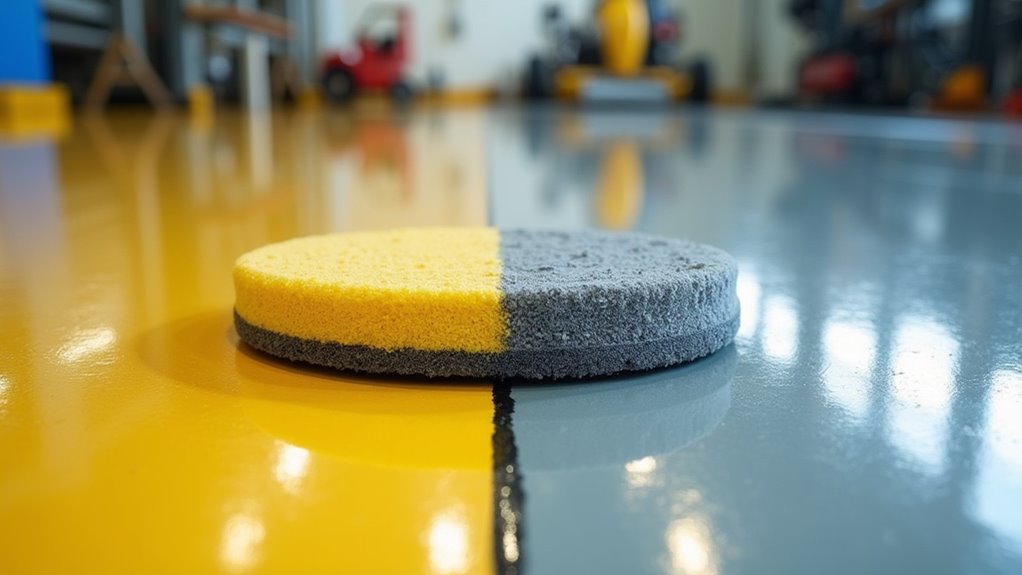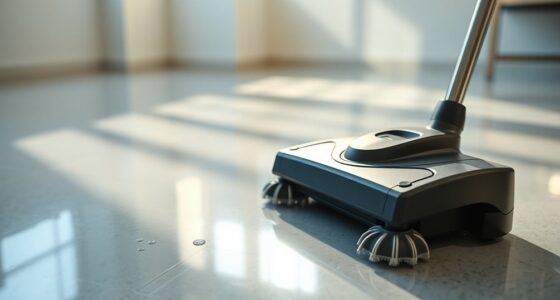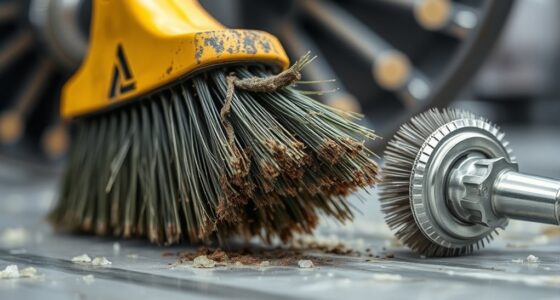When choosing between cylindrical and disc-shaped tools for cleaning epoxy floors, consider your cleaning needs. Cylindrical brushes are better for deep cleaning and stubborn dirt, as they make continuous contact and handle textured surfaces well. Disc-shaped tools excel at surface finishing and gentle cleaning, helping preserve the epoxy’s shine. Each has advantages depending on the task, but understanding their differences will help you select the most effective option—more details await as you explore further.
Key Takeaways
- Cylindrical tools excel at deep cleaning and removing stubborn dirt, especially on textured epoxy surfaces.
- Disc-shaped tools are ideal for routine maintenance, surface polishing, and minimizing surface scratches.
- Cylindrical brushes can handle aggressive cleaning with abrasives but risk damaging delicate epoxy if misused.
- Disc tools provide controlled abrasion, helping preserve epoxy surface integrity during cleaning.
- Choice depends on cleaning intensity: cylindrical for heavy-duty, disc for light or finishing tasks.

When choosing between cylindrical and disc-shaped tools for epoxy floors, understanding their differences can markedly impact your results. Both tools serve the purpose of cleaning and maintaining your epoxy surface, but their design and functionality influence how effectively they clean, especially when it comes to abrasive tools and cleaning protocols. Knowing which tool to use depends on the specific needs of your floor and the type of debris or stains you’re tackling.
Cylindrical tools are typically rotary brushes or scrubbers that spin around a central axis. They are well-suited for deep cleaning tasks, especially when dealing with stubborn dirt, grease, or grime embedded in textured epoxy surfaces. Their shape allows for continuous contact with the floor, providing consistent agitation that helps loosen debris. When paired with abrasive tools, cylindrical brushes can handle more aggressive cleaning protocols, making them ideal for heavily soiled floors or surfaces requiring thorough scrubbing. However, because of their robust action, you need to be cautious about not damaging the epoxy coating. For delicate surfaces, excessive scrubbing with abrasive tools might cause scratches or wear.
Disc-shaped tools, such as floor pads or polishing discs, offer a different approach. They are generally used for surface finishing, polishing, or light cleaning. These tools tend to be less aggressive, making them suitable for routine maintenance or when you want to preserve the epoxy’s shine. They work by providing uniform contact across a broad area, which makes them effective for buffing and smooth cleaning protocols. When paired with abrasive pads, disc-shaped tools can also handle tougher cleaning tasks but in a more controlled manner. This design minimizes the risk of over-scratching or damaging the epoxy while still allowing for effective removal of dirt and imperfections.
In terms of cleaning protocols, your choice hinges on the level of cleaning needed. For deep cleaning or heavily soiled floors, cylindrical tools with abrasive attachments are your best bet. They deliver aggressive action necessary to break down stubborn residues. Conversely, for routine maintenance or delicate surfaces, disc-shaped tools with softer or less abrasive pads are preferable. They can efficiently clean without compromising the integrity of your epoxy coating.
Additionally, understanding the proper use of abrasive tools can significantly influence the lifespan and appearance of your epoxy floors. Ultimately, both cylindrical and disc-shaped tools have their place in epoxy floor maintenance. Your decision should prioritize the condition of your floor, the type of debris involved, and your cleaning protocols. Using the right abrasive tools with the appropriate shape ensures you achieve a clean, polished surface without unnecessary damage, prolonging the beauty and durability of your epoxy flooring.
Frequently Asked Questions
Which Cleaning Tool Is More Cost-Effective Long-Term?
You’ll find that disc cleaning tools are more cost-effective long-term because they offer better cost efficiency and lower maintenance costs. They tend to last longer and require less frequent replacements, saving you money over time. Cylindrical tools might be cheaper upfront but often have higher maintenance costs and shorter lifespans. So, investing in disc tools now can lead to significant savings and easier upkeep later.
Do Cylindrical or Disc Brushes Damage Epoxy Surfaces?
You might worry about damaging your epoxy surface, but both cylindrical and disc brushes are designed to minimize abrasive damage. If used correctly, they won’t cause surface scratches or harm your epoxy floors. Just avoid applying excessive pressure and choose brushes with softer bristles for delicate areas. Proper technique guarantees effective cleaning without risking surface damage, so you can confidently select either option without fearing abrasive harm.
How Do Cleaning Tools Affect Epoxy Floor Longevity?
Your cleaning tools substantially impact epoxy floor longevity. Using brushes with rough surface textures or harsh cleaning chemicals can scratch or degrade the epoxy over time. Opt for soft-bristled brushes and gentle cleaning agents to preserve the surface. Regular, proper cleaning prevents dirt buildup that can cause damage, ensuring your epoxy floor stays durable and attractive longer. Proper maintenance with suitable tools and chemicals is key to extending its lifespan.
Are Certain Cleaning Tools Better for Industrial Epoxy Floors?
Think of your cleaning tools as the guardians of your epoxy floor’s integrity. For industrial epoxy floors, a mop’s effectiveness depends on using tools compatible with the surface, while abrasive pads must be carefully chosen to avoid damage. Cylindrical brushes often excel at reaching crevices, but discs provide gentle yet thorough cleaning. Select tools that balance power and care, ensuring longevity and a pristine finish.
Can Cleaning Tools Impact Epoxy Floor Slip Resistance?
Yes, cleaning tools can impact epoxy floor slip resistance. If you use abrasive materials or clean too aggressively, you risk damaging the surface and reducing slip resistance. Regular cleaning with gentle tools and appropriate techniques helps maintain a safe, non-slip surface. Keep in mind that cleaning frequency also plays a role; frequent, careful cleaning prevents buildup that could make the floor slippery or worn.
Conclusion
When it comes to cleaning epoxy floors, choosing between cylindrical and disc equipment depends on your needs. Notably, studies show that disc scrubbers can improve cleaning efficiency by up to 30% over cylindrical ones, thanks to their superior maneuverability and surface contact. Whichever you pick, prioritize proper maintenance and technique. Ultimately, selecting the right tool ensures your floors stay pristine and durable, helping you achieve professional results with less effort and time.









